Cat is a favorite pet of people around the world. Cats are intelligent and have an independent nature. These small animals can also be playful and entertaining. Many cats make affectionate, loyal pets, providing companionship for people of all ages. Tens of millions of cats are kept as pets worldwide.
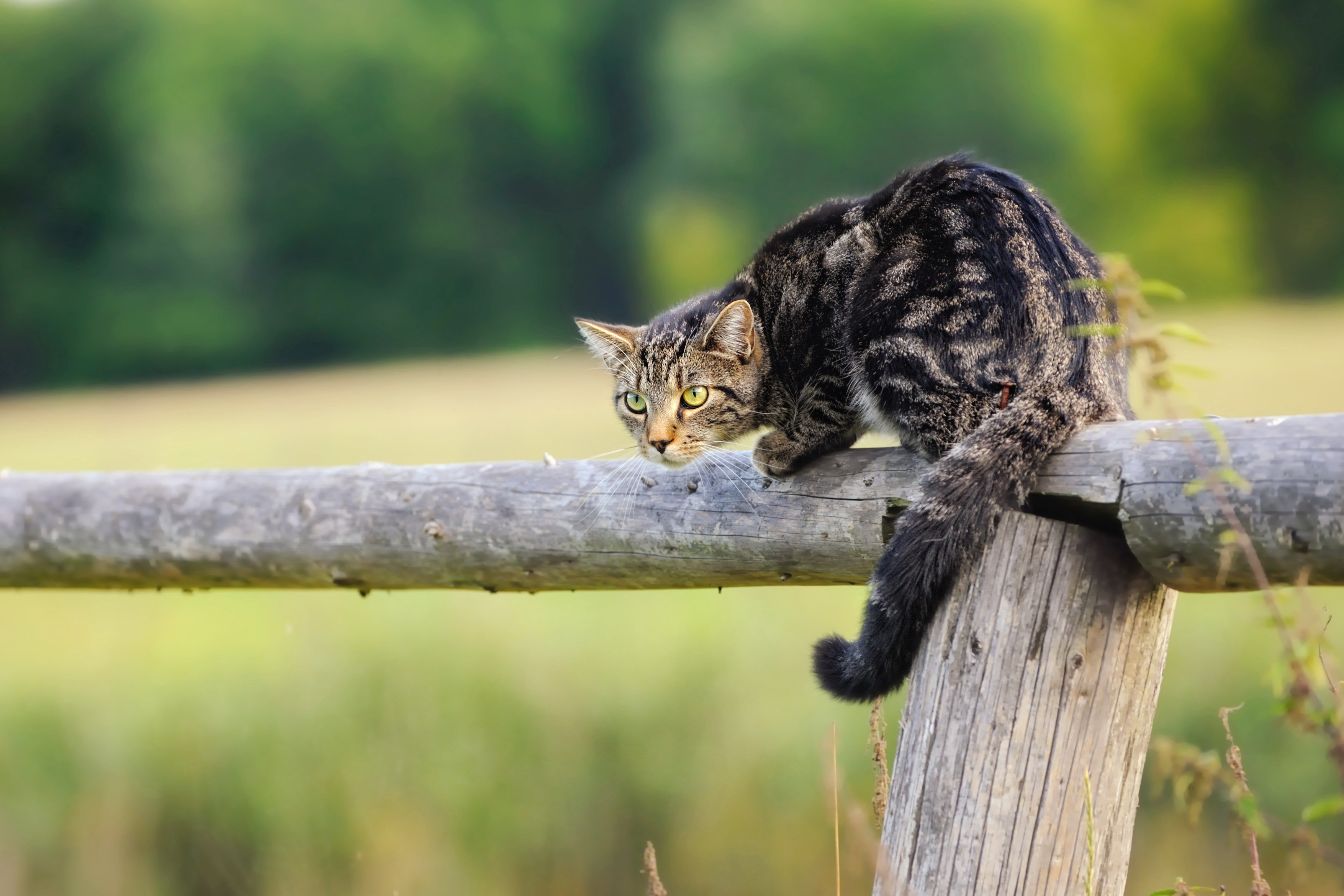
The word cat also refers to a family of meat-eating animals that includes tigers, lions, and leopards. This family also includes domestic cats—that is, those that people keep as pets. Domestic cats and their wild relatives share many characteristics. All these animals have long, powerful bodies and somewhat rounded heads. They have short, strong jaws and 30 sharp teeth. Cats are also skillful hunters. They are able to catch other animals by approaching them swiftly and quietly on padded feet. Or they may wait motionless until an animal comes close and then spring upon it suddenly.
This article deals with domestic cats. These animals have many special physical abilities. They see better in dim light than people do. They can climb trees, run at a high speed, and leap long distances. Cats also have a keen sense of balance and can easily walk along the tops of narrow fences or along narrow ledges. When cats fall, they almost always land on their feet.
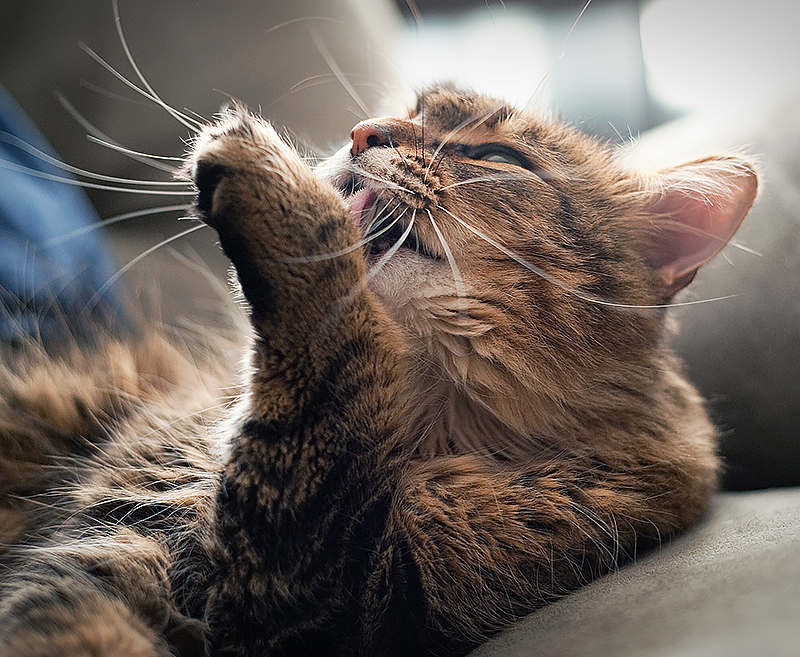
Cats vary in personality and in certain physical features, such as the length and color of their coats. There are many breeds of cats. Special characteristics set each breed apart from all others. Among the favorite breeds are the Siamese and the Persian.
No one knows exactly when the first cats were tamed. But some authorities believe cats were tamed about 5,000 years ago. Throughout history, people have valued cats for their skill at hunting and killing mice, rats, and snakes. Cats help keep farms, homes, and businesses free of these animals. The ancient Egyptians considered cats sacred. Today, people in many societies believe cats bring good fortune. But some people associate cats with bad luck and so fear them. Many people find cats mysterious because they move swiftly and silently and because their eyes seem to glow in the dark.
The grace and beauty of cats have made them favorite subjects of artists throughout history. Cats have also been featured in almost every type of literature. They appear in the mythology of ancient Greece and Rome. Hundreds of years ago, Asian writers praised cats in their stories and poems. Cats are also commonly mentioned in the fairy tales, folklore, and legends of many countries. In modern times, books, comic strips, motion pictures, and television programs have featured cats.
The body of a cat
Body size and structure.
Adult cats average about 8 to 10 inches (20 to 25 centimeters) tall at the shoulder. Most weigh from 6 to 15 pounds (2.7 to 7 kilograms). But some cats weigh more than 20 pounds (9 kilograms), and some weigh less than 5 pounds (2.3 kilograms).
Cats have the same basic skeleton and internal organs as human beings and other meat-eating mammals. The skeleton of a cat has about 250 bones. The exact number of bones varies, depending on the length of the cat’s tail. The skeleton serves as a framework that supports and protects the tissues and organs of a cat’s body. Most of the cat’s muscles are long, thin, and flexible. They enable a cat to move with great ease and speed. Cats can run about 30 miles (48 kilometers) per hour.
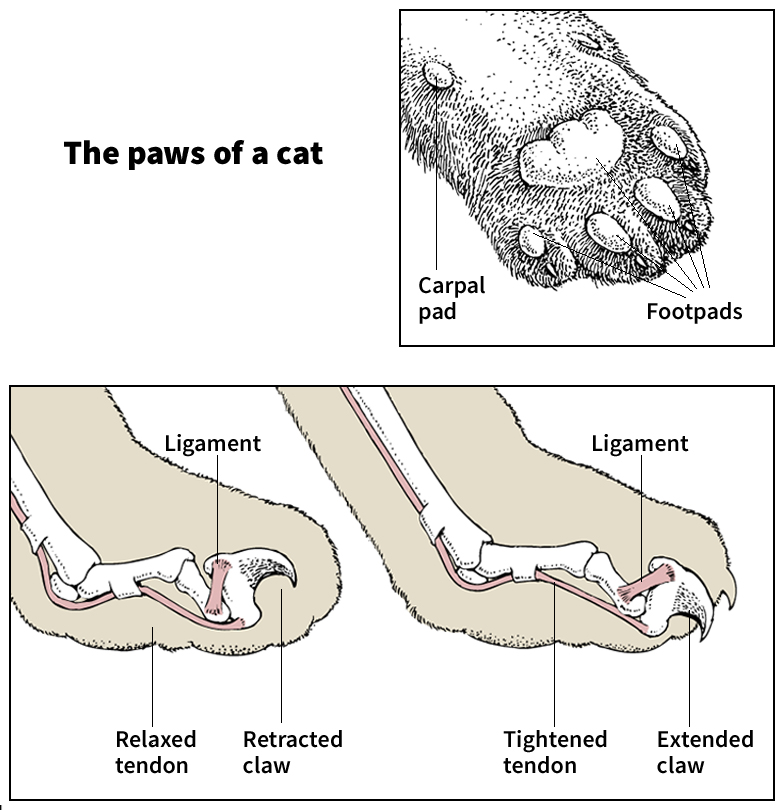
The arrangement of the bones and the joints that connect them permits a cat to perform a variety of movements. Unlike many animals, a cat walks by moving the front and rear legs on one side of its body at the same time, and then the legs on the other side. As a result, a cat seems to glide. Its hip joint enables a cat to leap easily. Other special joints allow a cat to turn its head to reach most parts of its body.
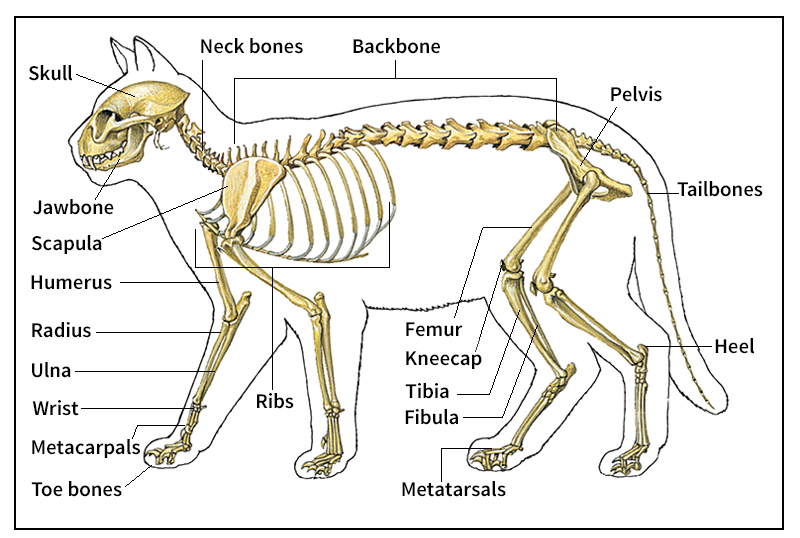
A cat has five toes on each forepaw, including a thumblike inner toe that is helpful in catching prey. Each hindpaw has four toes. Some cats have extra toes. Each of a cat’s toes ends in a sharp, hooklike claw. The claws usually are retracted (held back) under the skin by elastic ligaments, which are a type of connective tissue. However, when the claws are needed, certain muscles quickly pull the tendons (cordlike tissues) connected to the claws. This action extends the claws. A cat uses its claws in climbing, in catching prey, and in defending itself. Several spongy pads of thick skin cover the bottoms of a cat’s feet. The pads cushion the paws and enable a cat to move quietly.
A cat’s tail is an extension of its backbone. The flexible tail helps a cat keep its balance. When a cat falls, it whips the tail and twists its body to land on its feet.
Head.
A cat’s head is small and has short, powerful jaws. Kittens have about 26 needlelike temporary teeth, which they shed by about 6 months of age. Adult cats have 30 teeth, which are used for grasping, cutting, and shredding food. Unlike human beings, cats have no teeth for grinding food. But a cat’s stomach and intestines can digest chunks of unchewed food. Tiny hooklike projections called papillae cover a cat’s tongue, making it rough. The rough surface of the tongue helps a cat lick meat from bones and groom its coat.
A cat has a small, wedge-shaped nose. The tip is covered by a tough layer of skin called nose leather. The nose leather may be various colors. It is usually moist and cool. A sick cat may have a warm, dry nose.
The colored part of a cat’s eyes, called the iris, may be shades of green, yellow, orange, copper, blue, or lavender. Odd-eyed cats have irises of different colors. For example, one eye may be green and the other blue.
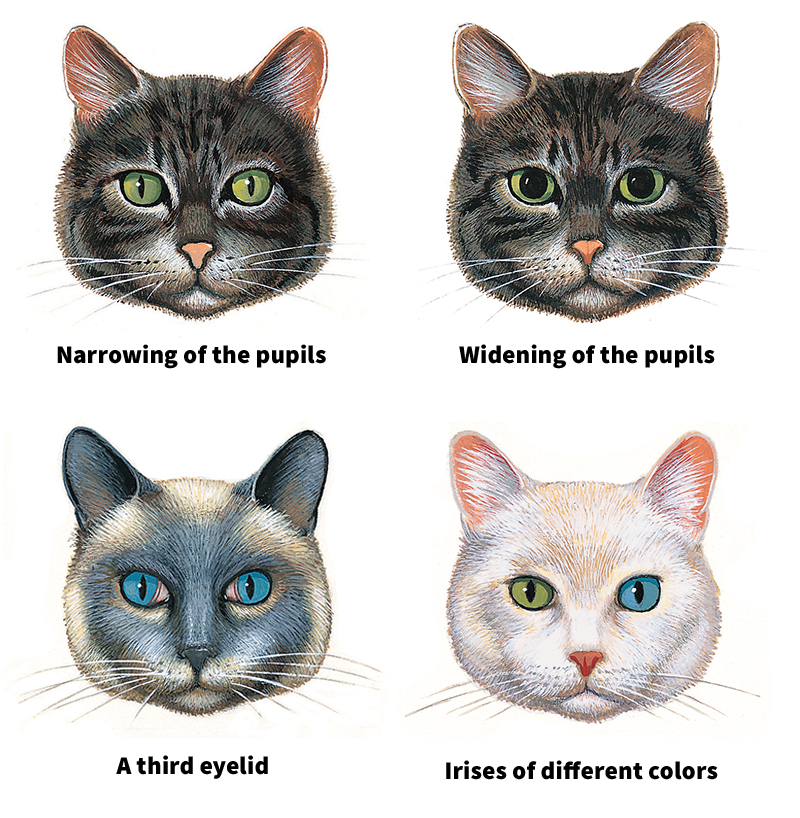
At the back of each eye, a cat has a special mirrorlike structure called the tapetum lucidum. It reflects light and so helps a cat see in dim light. It also produces eyeshine, the glow a person sees when light strikes the eyes of a cat at night. Each of a cat’s eyes has a third eyelid at the inner corner. This structure, called the nictitating membrane, protects and lubricates the eyes.
A cat’s ears are near the top of its skull. Each ear can move independently. A cat can aim the cup of its ears in the direction from which a sound is coming and so improve its hearing.
Coat.
A cat’s coat protects its skin and provides insulation. Most coats have two types of hairs. The outer part of the coat is made up of long, stiff primary, or guard, hairs. The undercoat consists of softer and shorter secondary, or down, hairs. The color, length, and texture of the coat vary greatly among cats. The Sphynx breed of cat, in fact, may have no hair. Terms commonly used to describe the color of a cat’s coat are solid or self, smoke, shaded, tabby, parti-color, and colorpoint.
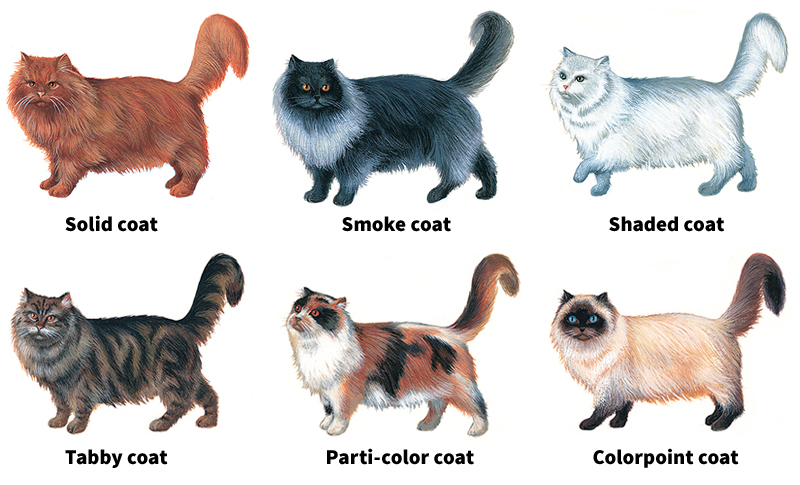
Solid, or self, coats have only one color. The solid colors are black, blue (dark gray), brown, cream (tan), lilac (light gray), red (shades of orange), and white.
Smoke coats consist of a white undercoat covered by guard hairs of a dark color. In most cases, the guard hairs are black, blue, or red.
Shaded coats are similar to smoke coats except that the dark color is limited to the tips of the guard hairs. A chinchilla coat has a sparkling appearance because only the extreme tips of the guard hairs are dark. Red chinchilla coats are sometimes called shell cameos.
Tabby coats are symmetrically patterned with stripes and blotches of a dark color on a lighter background. The patterns are formed by bands of a dark color on individual hairs. Tabby colors include blue, brown, cream, red, and silver. Mackerel tabbies have narrow markings.
Parti-color coats have two or more clearly defined colors, such as black and white or blue and cream. Tortoiseshell coats are black, red, and cream. Calico coats have patches of white, black, red, and cream.
Colorpoint coats consist of a solid color over the trunk of the body and a contrasting color on the points. The points include the face, ears, feet, and tail.
Senses.
A cat’s vision is not as keen as that of a human being. Cats probably see most colors as various shades of gray. However, they can detect the slightest motion, which is helpful in hunting. They see well in dim light but cannot see in total darkness.
Cats have a highly developed sense of smell. Newborn kittens, for example, are able to recognize their nest by scent alone. In addition to its nose, a cat has another sense organ in its mouth that detects scents.
Cats also have a keen sense of hearing. They hear a much broader range of sounds than people do. Deafness is rare among cats. However, it is an inherited defect among some white cats, particularly those with blue or odd-color eyes.
The whiskers of a cat are special hairs that serve as highly sensitive touch organs. These hairs, called vibrissae or tactile hairs, grow on the chin, at the sides of the face, and above the eyes. The hairs are attached to nerves in the skin, which transmit signals to the brain when the whiskers brush against objects. The whiskers may help a cat protect its eyes, feel its way in the dark, and detect changes in wind direction.
Breeds of cats
The many breeds of cats vary greatly in appearance. Cat breeders have developed numerous breeds by selectively mating animals with certain desirable and distinctive characteristics. These characteristics appear consistently in the offspring of purebred cats. A purebred cat is one whose mother and father belong to the same breed. The offspring of cats that have mated randomly are known as crossbreds or alley cats.
Many people prefer the special features of a certain breed of cats. For example, such purebreds as the Abyssinian and the Birman are among the most beautiful and unusual animals in the world. But crossbreds may be just as beautiful and lovable as purebreds, and they are often healthier.
Certain associations officially recognize cat breeds and establish standards for the ideal characteristics of each breed. However, different cat associations recognize different breeds, and breed standards also vary somewhat. In the United States, cat breeds are commonly divided into two major groups: (1) short-haired breeds and (2) long-haired breeds. Some breeds include both long- and short-haired types.
Short-haired breeds.
The Cat Fanciers’ Association (CFA), the major U.S. cat association, recognizes numerous short-haired breeds. They include the Abyssinian, American shorthair, American wirehair, Bombay, British shorthair, Burmese, Chartreux, Colorpoint shorthair, Cornish rex, Devon rex, Egyptian Mau, Exotic, Havana brown, Japanese bobtail, Korat, Manx, Ocicat, Oriental, Russian blue, Scottish fold, Selkirk rex, Siamese, Singapura, Sphynx, and Tonkinese.
Abyssinian
is a slender, muscular, medium-sized cat with a long, tapering tail. Aby cats, as they are sometimes called, have a wedge-shaped head and large ears. Their almond-shaped eyes are commonly green, gold, or hazel. These cats are known for their agouti coat pattern, which is common in wild animals. Each hair of an Aby’s soft coat has two or three bands of alternating light and dark colors. The bands may be a variety of colors, ranging from cream and silver to bluish tones to black and shades of brown and brownish-red.
People once thought the Aby originated in Abyssinia (now called Ethiopia) and descended from the sacred cats of ancient Egypt. Today, some cat experts believe the Aby probably originated in Southeast Asia. Cats resembling the Aby were brought to the United Kingdom from Abyssinia in the mid-1800’s.
American shorthair
is a muscular, medium- to large-sized animal. Its large head features full cheeks; a broad, squarish muzzle; large, round eyes; and rounded, medium-sized ears. The coat and eyes may be any color. The breed probably developed from cats originally brought to the American Colonies by Europeans.
American wirehair
is a medium- to large-sized cat with a rounded head and roundish ears and eyes. It has dense, springy, coarse fur and curly whiskers. The coat may be any color or pattern. This breed originated as a mutation (random genetic change) in a litter of upstate New York farm cats in 1966.
Bombay
looks somewhat like a miniature black panther. It has a sleek black coat and golden to reddish-brown eyes. This medium-sized breed originated in 1958 in Louisville, Kentucky, as a cross between a black American shorthair and a Burmese.
British shorthair
traces its ancestry to domestic cats that lived thousands of years ago in parts of Europe, including what is now the United Kingdom. This medium- to large-sized cat typically has a massive, roundish head; large, round eyes; and ears with rounded tips. It is similar to the American shorthair but has a stockier build and a thicker coat.
Burmese
is a medium-sized cat with a muscular body. The cat has round, golden eyes and a short, sleek coat that most commonly is dark brown. The Burmese has round, golden eyes. The breed was developed from a female cat that was brought to the United States from Burma (now Myanmar) in 1930.
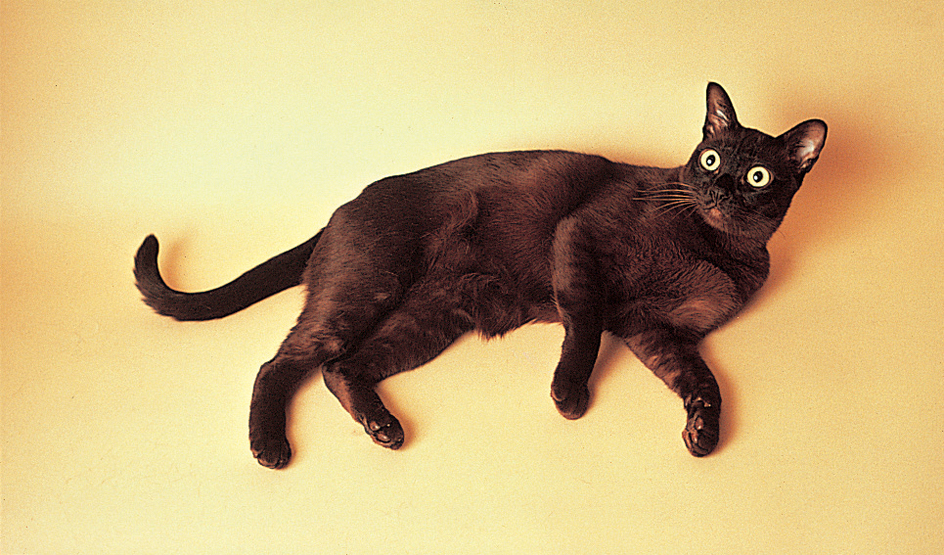
Chartreux
is a breed believed to have been brought to France from South Africa by Carthusian monks in the 1600’s. This medium- to large-sized cat has a blue-gray coat with a slightly woolly texture. Its eyes may be reddish-brown to golden or brilliant orange. The Chartreux is strong, friendly, and intelligent.
Colorpoint shorthair
was developed in England in the early 1900’s by crossing Siamese, red British shorthair, and Abyssinian cats. Like the Siamese, this medium-sized breed has a slender body, blue eyes, and a colorpoint coat.
Cornish rex
has a short, silky, wavy coat and a greyhoundlike body. The coat, which may be any color, has no guard hairs. This slender, small- to medium-sized cat has a long tail, small head, large ears, and a curved nose. The Cornish rex originated in Cornwall, England, about 1950 as a cross between a tortoise-shell cat and a white barn cat.
Devon rex
is a strong, medium-sized cat with large eyes, a short muzzle, and huge, low-set ears that give it an elfin appearance. Its soft, wavy coat may be any color. The breed originated in Devonshire, England, in 1960 as a mutation of barn cats.

Egyptian Mau
is one of the oldest breeds of domestic cats, dating back to about 1400 B.C. The Egyptian Mau << mow >> has a distinctive coat of dark spots against a lighter background. The spots become bars on the face, legs, and tail. This graceful, medium-sized cat has a rounded head and light green eyes.
Exotic
was developed in the United States during the 1950’s and 1960’s by crossing American shorthair and Persian cats. The Exotic is a stocky, medium-sized cat with a snub nose, large round eyes, and small rounded ears. Its coat, which varies in color and pattern, is short, soft, and thick.
Havana brown
is a strong, medium-sized cat with a solid, reddish-brown coat. It has a long head and oval, vivid green eyes. The breed was developed in England during the late 1940’s and early 1950’s from mating a black British shorthair and a Siamese cat. The Havana brown is friendly to other cats and to people.
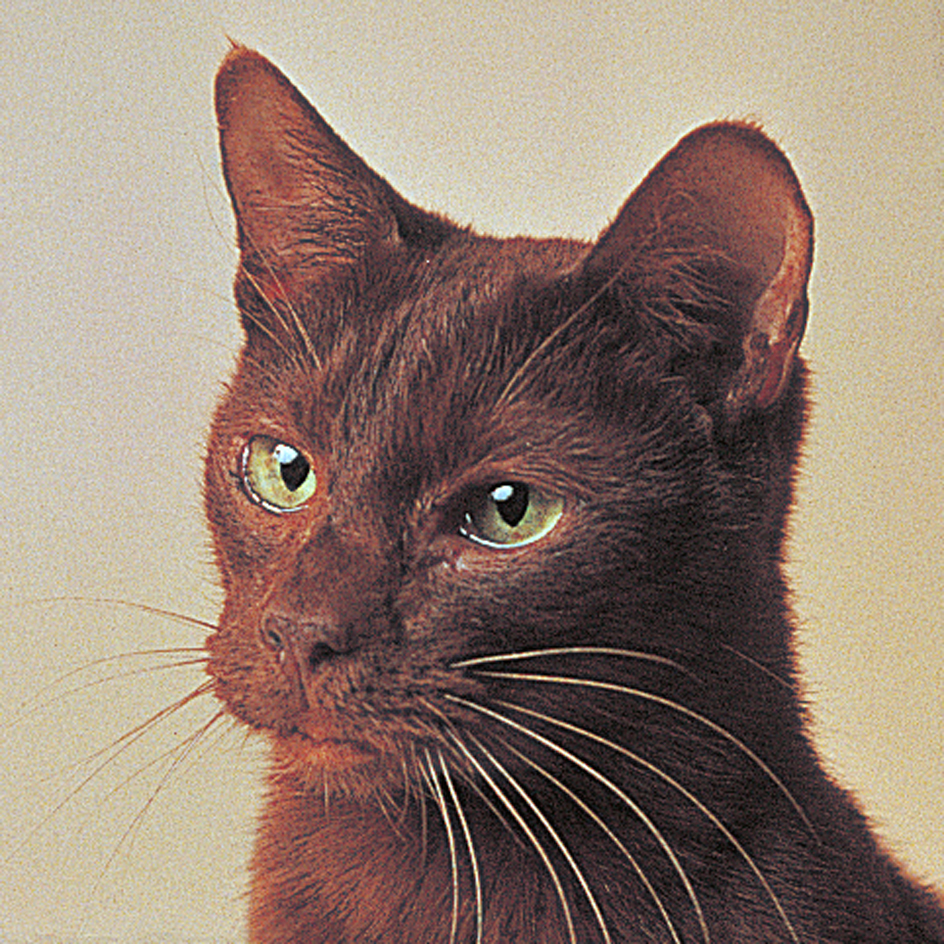
Japanese bobtail
has a short, rigid tail with bushy hair. This slender, medium-sized animal has been raised in Japan for hundreds of years. Some Japanese believe the bobtail brings good luck. Many works of art portray this cat seated with a paw raised in greeting.
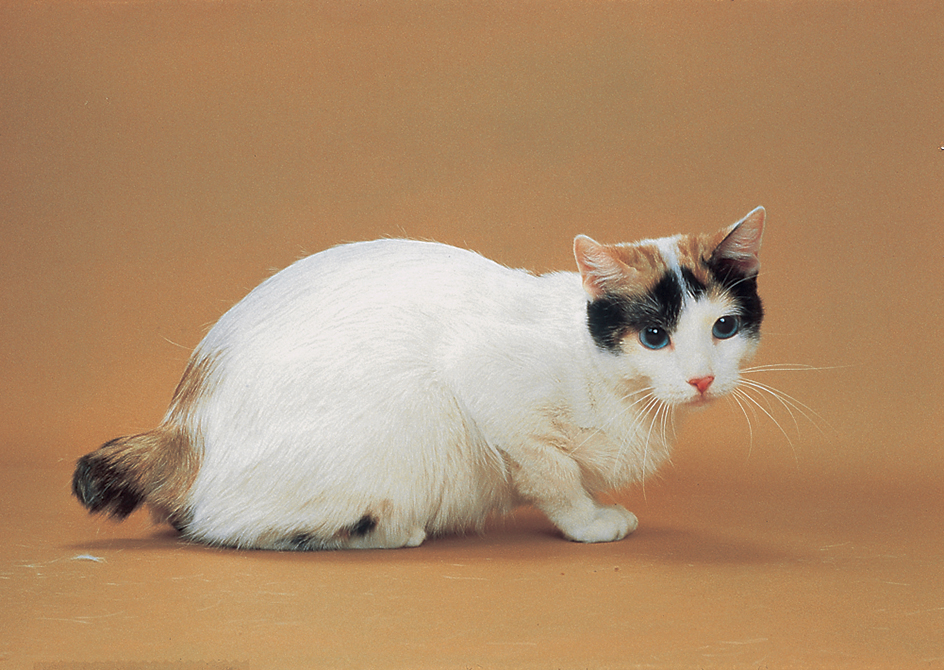
The bobtail has a triangular head with a long nose, slanted eyes, and large ears. It has silky, medium-length fur. Some types of the bobtail have long hair. The coat may be any color. But the traditional “good luck” color of the coat is white with patches of red and black. The playful bobtail has a soft voice and adapts well to other animals and to new surroundings.
Korat
is a quiet, gentle animal that originated in Thailand between 1350 and the late 1700’s. In Thailand, this breed is believed to bring good luck. It is a muscular, medium-sized cat with a rounded back. The Korat has a heart-shaped face and large, luminous green eyes. Its short, silvery-gray coat lies flat.
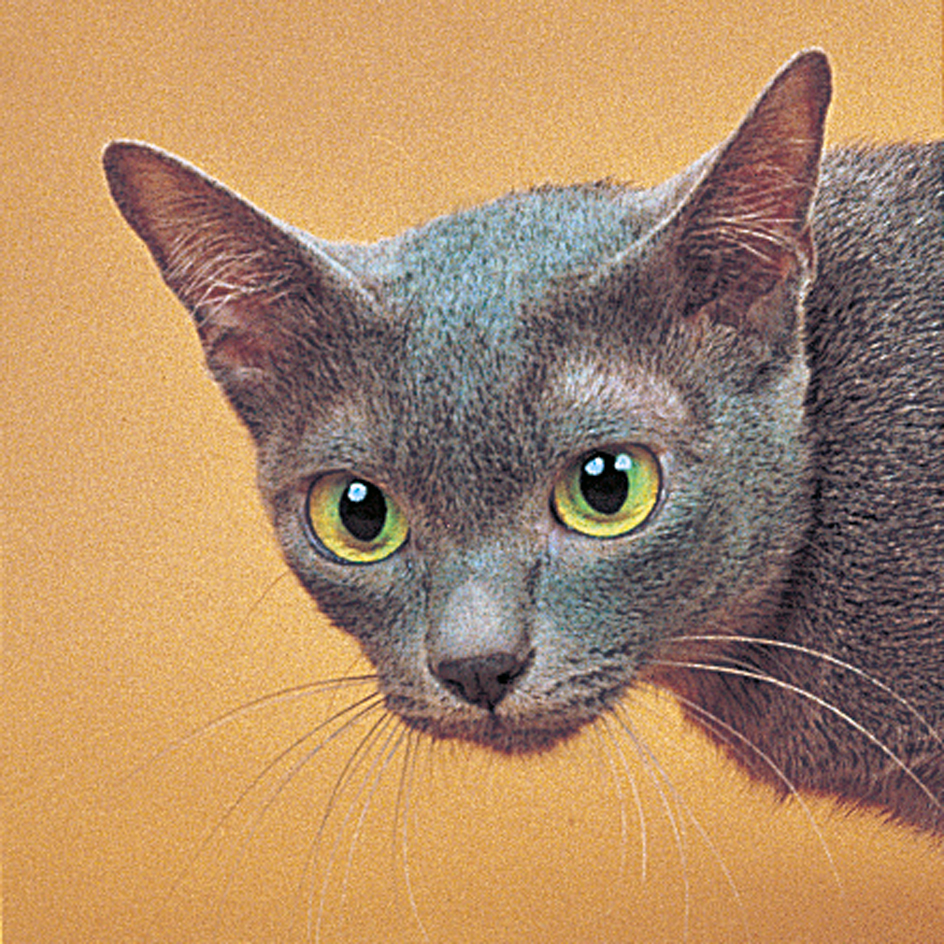
Manx
is named for the Isle of Man in the Irish Sea, where the breed originated hundreds of years ago. Types of Manx cats include the rumpy, rumpy-riser, stumpy, and longie. The most common is the rumpy, which is the only kind of cat without a tail. The cat has a notch where the tail would normally be. The rumpy-riser has a short knot at the tail base. The stumpy has an extremely short tail, and the rare longie has a full-length tail. The playful, sweet-natured Manx has a small body with a round head, broad chest, arched back, and high rump. The muscular rear legs are longer than the front legs. The cat runs with a rabbitlike hop. Its coat and eyes may be any color.
This breed also includes a long-haired type. The long-haired Manx used to be called the Cymric.
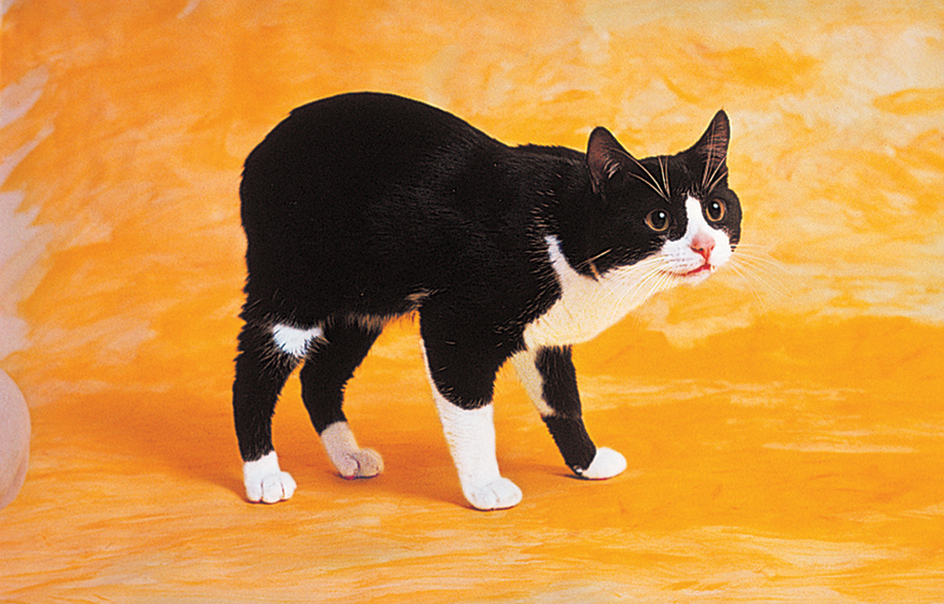
Ocicat
resembles a wild spotted cat. It has a short, sleek, agouti spotted coat and a large, muscular body. Its coat and eye color varies. The breed originated in Michigan in 1964 by crossing Abyssinian, Siamese, and American shorthair cats. Ocicats are easy to train.
Oriental
was developed in England as early as 1950 by crossing Siamese, British shorthair, and Abyssinian cats. The Oriental looks like the Siamese except for its coat and eye color. The eyes are green except in white cats, which can have blue eyes. The coat may be any solid or tabby color. This breed also includes a long-haired type, which was developed in Europe and North America during the 1980’s. The long-haired Oriental has a fine, feathery tail plume.
Russian blue
has short, extremely thick, bluish-gray fur that is unlike the fur of any other cat. The plush coat seems to glitter because the guard hairs are silver-tipped. The Russian blue has a large, muscular body, long legs, and a long tail. The cat’s wedge-shaped head features large ears, a flat forehead, and round green eyes. Despite its name, the origin of this breed is unclear. The animal was brought to England from Russia or northern Europe in the 1800’s.
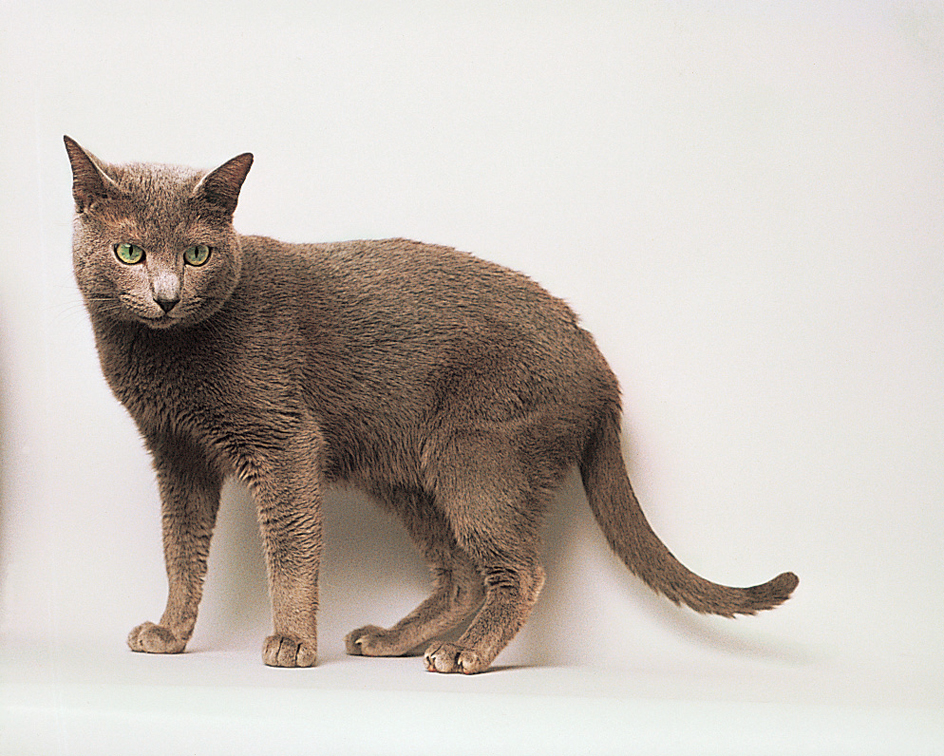
Scottish fold
is a medium-sized cat with ears that fold toward the face and downward. Its coat may be any color and pattern. Some types of Scottish fold have long fur. This cat has a roundish body and head and large round eyes. The breed was developed from a farm cat found in Scotland in 1961 that had folded ears as a result of a natural mutation. The Scottish fold has a soft voice and is gentle and affectionate.
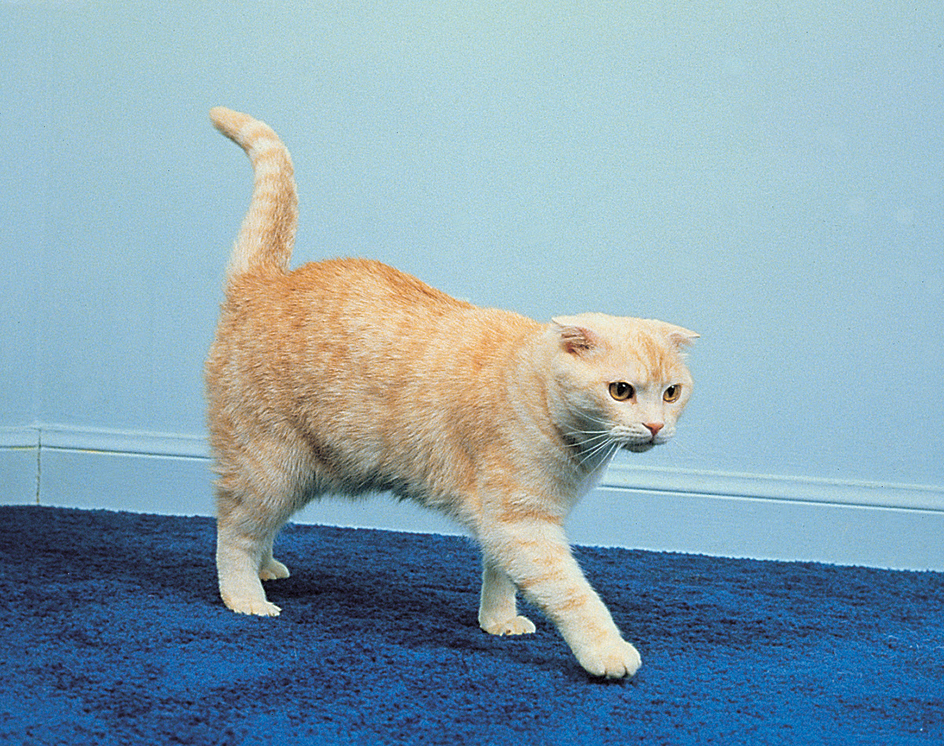
Selkirk rex
is a large cat with curly, plush fur. Its medium-length coat may be any color and pattern. Some types of Selkirk rex have long hair. The breed originated in Montana near the Selkirk Mountains in 1987 from mating an unusual-looking curly cat found in an animal shelter with a Persian cat. Selkirk rex has a round head, large eyes, and full cheeks that give it a sweet expression.
Siamese
is the most popular short-haired cat. It is best known for its fine, glossy colorpoint coat. The Siamese is a loving pet that seems less independent than other breeds. Siamese cats often utter loud, mournful meows until they get attention.
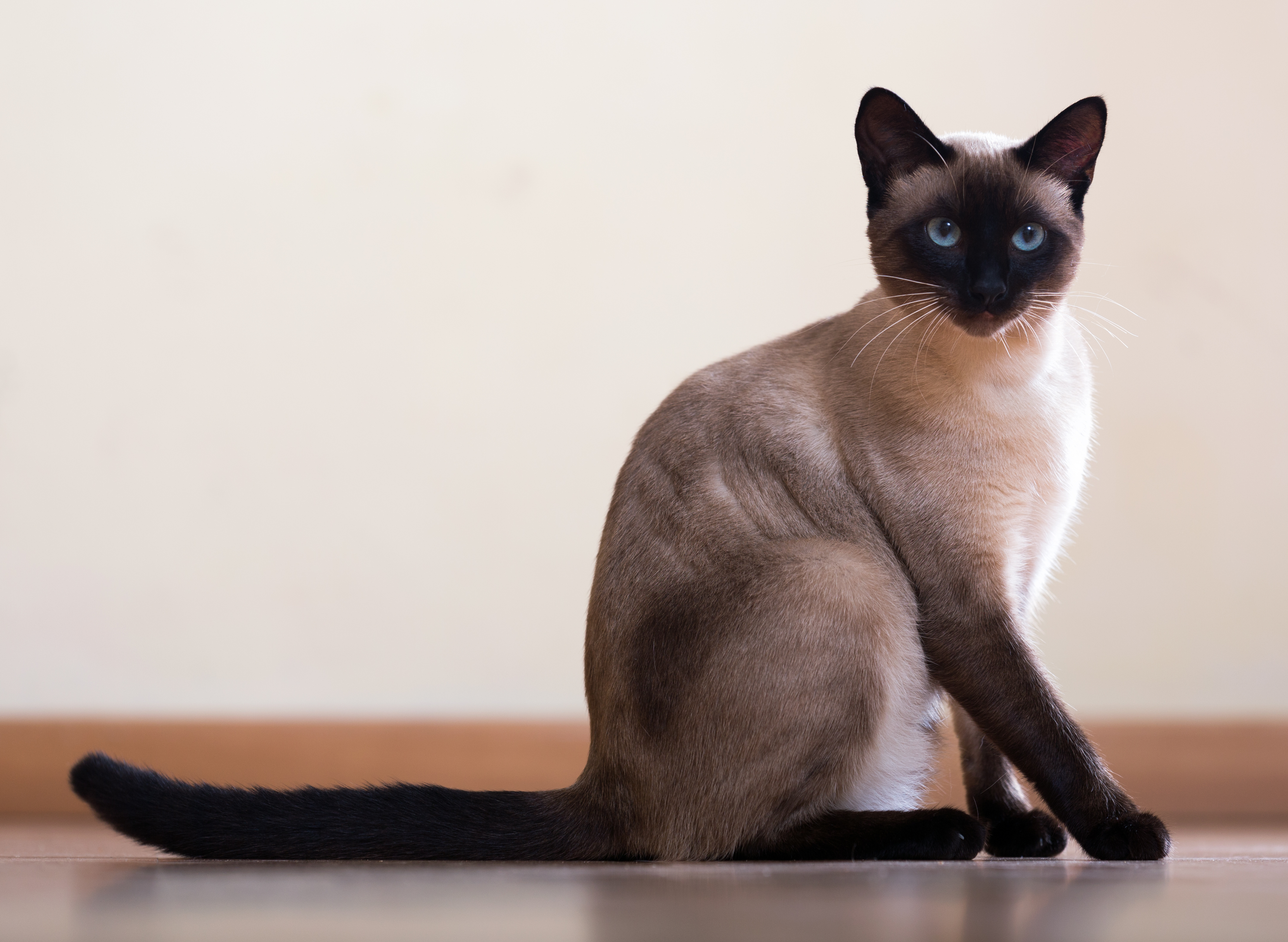
The Siamese has a long, slender, medium-sized body and a thin tail. Its legs are slim, and its paws small. Its long, wedge-shaped head has straight sides and large, pointed ears. Its eyes are almond-shaped and deep blue. The fur on the trunk of its body is a solid light color. The points are one of four colors—blue, chocolate, lilac, or seal (dark brown). Siamese kittens are born white but develop their adult color within a year.
The Siamese originated in Thailand (formerly called Siam). There, these cats were royal property and guarded palaces and temples. In 1884, a pair of Siamese were brought to the United Kingdom. Their offspring won many prizes at cat shows, and the breed soon gained worldwide popularity.
Singapura
is a small- to medium-sized, muscular cat with strikingly large ears. Its fine, short coat has dark brown marks on a whitish background. The eyes have hazel, green, or yellow coloring. The Singapura originated from three cats found in Singapore during the early 1970’s.
Sphynx
is a medium-sized cat with large ears and a hairless or nearly hairless body. It can have a variety of skin colors. The Sphynx was developed from a cat born in Canada in 1966.
Tonkinese
is a medium-sized cat with almond-shaped, aqua eyes. Its fine, silky fur may be various shades of brown or blue with a colorpoint pattern. The breed originated in the United States around 1930 as a cross between Siamese and Burmese cats.
Long-haired breeds.
The long-haired cat breeds recognized by the Cat Fancier’s Association include the American curl, Balinese, Birman, Javanese, Maine coon, Norwegian forest cat, Persian, ragdoll, Siberian, Somali, Turkish Angora, and Turkish van.
American curl
is a medium-sized cat with firm, erect ears that curve up and back from the face toward the center of the back of the head. Its fur may be any color or pattern. Some types have short fur. The eyes may be any color. The American curl traces its origin to a black, long-haired female cat that was found in California in 1981. The breed was developed by mating this cat and her offspring to various domestic short- and long-haired cats.
Balinese
was developed from the Siamese and has the same body structure and coloring. But the fine, silky fur of the Balinese is about 2 inches (5 centimeters) long and has no undercoat. The hair on its long tail spreads out like a plume. The Balinese became an established breed in the United States during the 1960’s.

Birman
is a large, long-bodied cat with a bushy tail and short legs. Its head is round with a curved nose, round blue eyes, and rounded ears. The cat’s long, silky coat has a colorpoint pattern, except that the large, rounded paws are always white. The Birman is a gentle, affectionate animal. The breed originated in what is now Myanmar, where it is considered sacred.
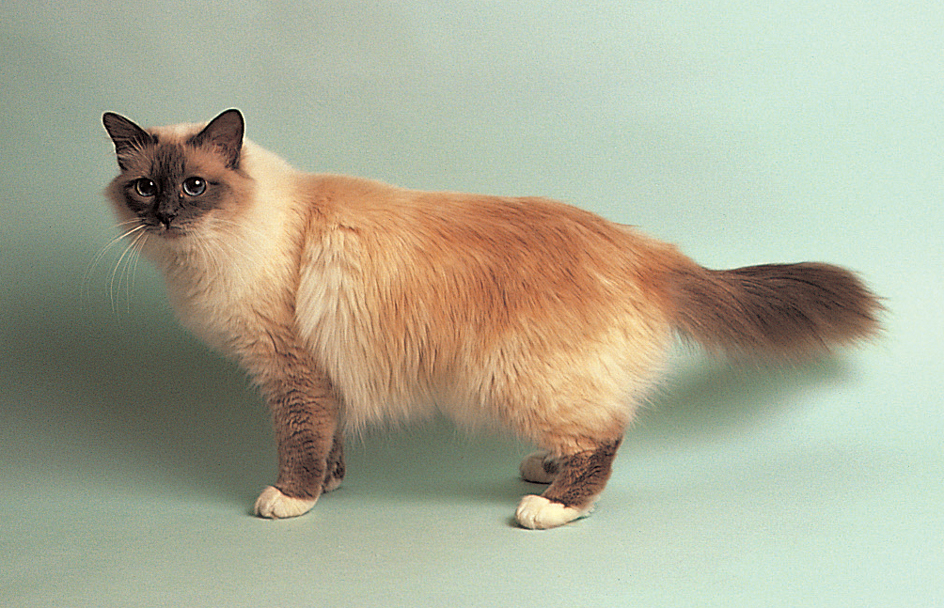
Javanese
was developed during the late 1960’s and early 1970’s in the United States by crossing the Balinese with the colorpoint shorthair. Javanese cats are identical in appearance to colorpoint shorthair cats except for their long, silky coats.
Maine coon,
the largest cat, looks somewhat like a raccoon. Its heavy, silky coat is medium length and may be any color. Its fur falls smoothly over most of the body but is shaggy on the ruff, stomach, and tail. A ruff is a fringe of long hairs that circles the neck.
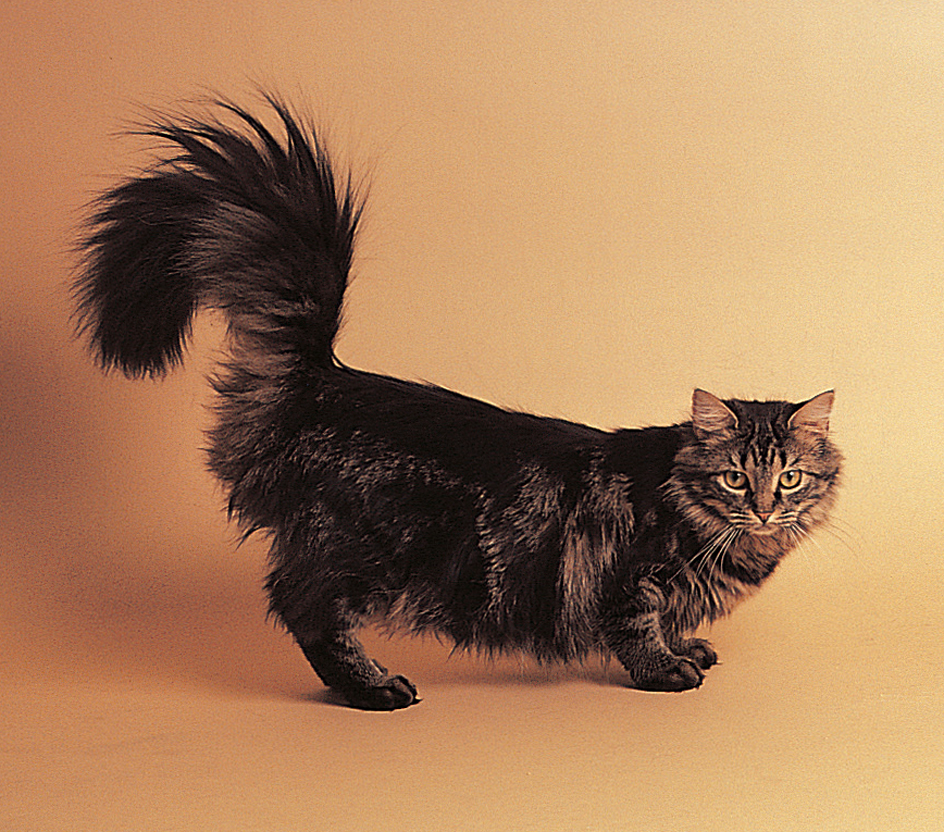
The broad, muscular body of the Maine coon has an almost rectangular shape. Its head features a long nose and large eyes and ears. The cat stands on sturdy, medium-length legs. Tufts of fur cover its large, round paws, which are well suited to running across ice and snow. The breed developed in New England during the 1800’s, probably as a result of matings between American shorthairs and long-haired cats brought to Maine by sailors prior to the 1850’s.
Norwegian forest cat
is an ancient breed that is mentioned in Norwegian mythology. It is a large, muscular cat with a triangular head and large ears with prominent tufts. Its thick fur, which can be any color, has a woolly undercoat and an abundant ruff. Its oval eyes are usually a green-gold color except in white cats, which often have copper or blue eyes or are odd-eyed.
Persian
is the most popular breed of long-haired cats. This animal has a stocky, medium- to large-sized body with short, strong legs. Its large, round head includes a snubbed nose; large, wide-set, round eyes; and small, rounded ears. The Persian is admired for its extremely long, fine-textured, glossy coat. Its fur stands out from the body and forms a large ruff and a full, brushlike tail. The coats of Persians vary in color and pattern. Most Persians have copper eyes.
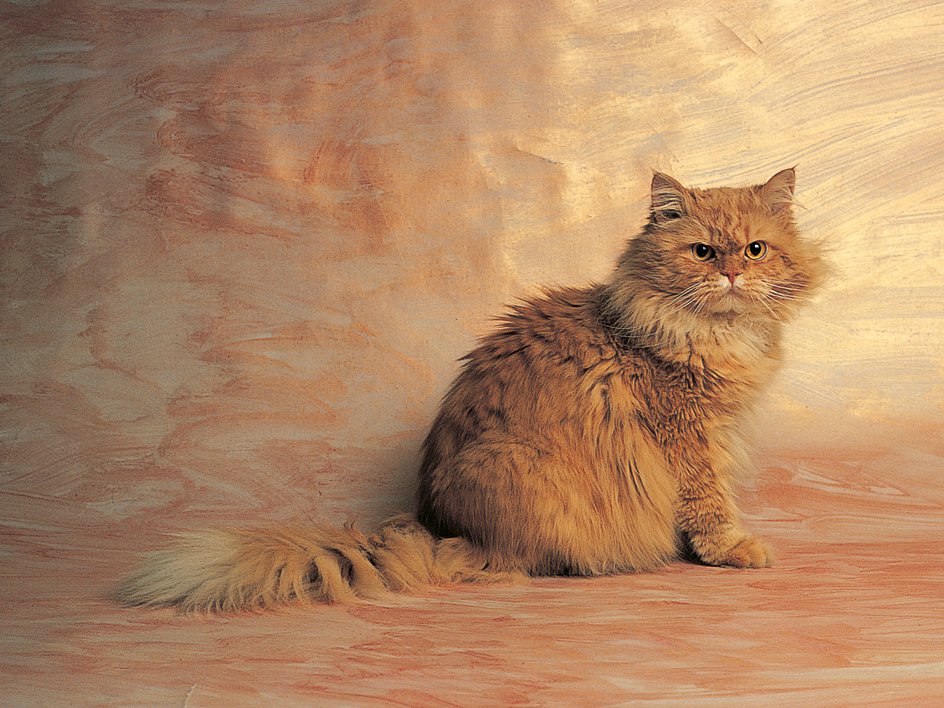
The exact origin of the Persian is unknown. But the breed probably lived in the Middle East more than 3,000 years ago. Persians have been carefully bred for hundreds of years to develop their present distinctive appearance.
Ragdoll,
a large-sized cat, gets its name from its limpness. When a ragdoll cat is picked up, it relaxes completely and flops over like a ragdoll. Its thick fur is similar to the Birman’s fur in color and pattern except that many ragdolls have white markings on the face, ruff, and stomach. The ragdoll is a fearless and calm animal. The breed originated in the United States in the 1960’s.
Siberian,
a medium- to large-sized cat, has a moderately long coat of any color. The coat becomes noticeably thicker during cold weather. This Russian breed may have been developed at least 1,000 years ago.
Somali
looks like the Abyssinian except for its soft, medium-length double coat, which has blue, reddish, or brown bands. The eye color is gold or green. The breed developed from the offspring of Abyssinian cats that were born in the United Kingdom around 1900.
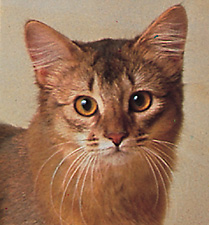
Turkish Angora
is one of the oldest breeds. The cat originated in Turkey and spread throughout Europe during the 1700’s and 1800’s. Beginning in the early 1900’s, Angoras were commonly crossed with Persians. As a result, the pure Angora nearly became extinct. Only a few remained by the early 1960’s. Then, cat breeders and officials of the zoo in Ankara, Turkey, established a breeding program that saved these cats.
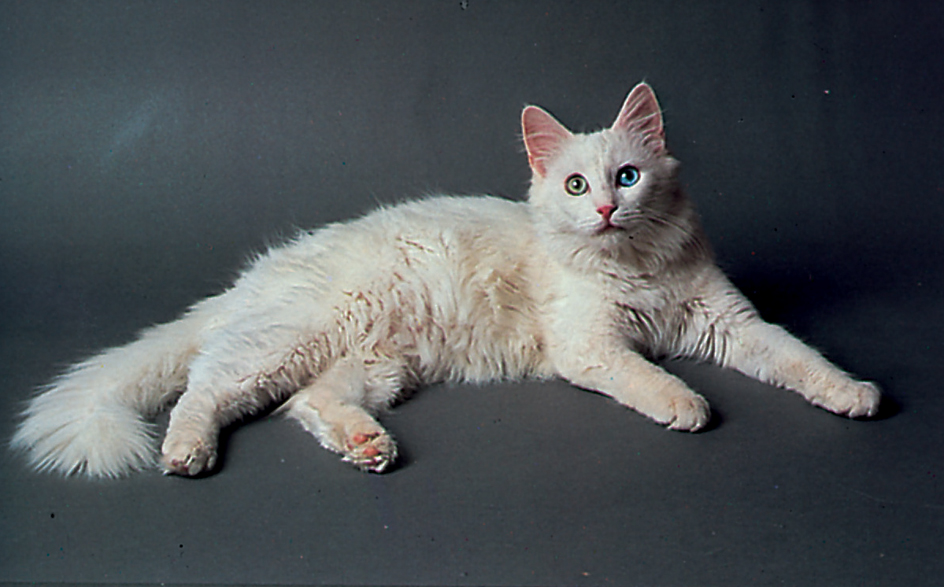
The Turkish Angora has a medium-sized, long, slender body. Its wedge-shaped head includes a long nose and long, pointed ears. Its silky, medium-length hair forms big tufts on the ears and between the toes. The color of the coat and eyes varies. This affectionate cat is known for its intelligence.
Turkish van
is a rare and ancient breed that originated in the Lake Van area of southeastern Turkey, where it is considered a regional treasure. Crusaders brought the animal to Europe during the Middle Ages, from about the A.D. 400’s through the 1400’s. Turkish van cats are also known as swimming cats because they love water. Their cashmerelike, medium-long fur is pure white except for markings on the head and tail. The eyes may be blue, amber, or odd-eyed. The Turkish van’s body is similar to the Turkish Angora.
Other breeds.
There are many other breeds of cats around the world. Some breeds are extremely rare and unusual. Other breeds are popular in only one country or area. Still others have been developed recently and have not yet gained wide recognition.
The life of a cat
Most healthy cats live from 12 to 15 years. But many reach 18 or 19 years of age, and some have lived longer than 30 years.
Reproduction.
A queen (female cat) can begin mating when she is between 5 and 9 months old, and a tom (male cat) can begin when he is between 7 and 10 months old. Toms can mate at any time. Queens mate only during a period of sexual excitement called estrus or heat. Estrus usually occurs during the spring and sometimes during the fall. This period is the breeding season. Estrus usually lasts from 6 to 10 days. If a queen is prevented from mating while she is in heat, she will probably come into heat again within 3 weeks. In most cases, this cycle recurs during the breeding season until the queen becomes pregnant.
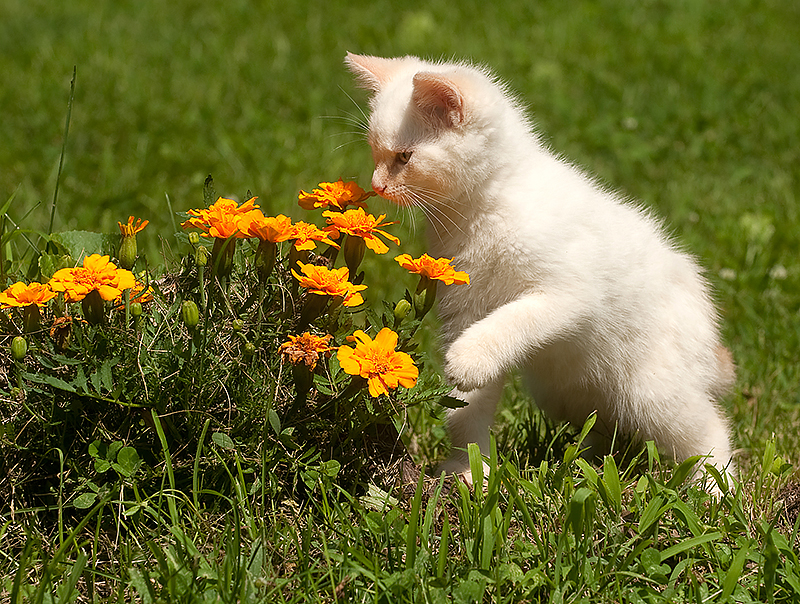
The pregnancy period among cats lasts about nine weeks. When a queen is ready to give birth, she selects a quiet, safe spot as a nest. On the average, a queen bears from 3 to 5 kittens at a time. However, litters of as many as 14 kittens have been reported. The mother can deliver the kittens herself with no human assistance, unless complications develop.
Most newborn kittens weigh about 3 1/2 ounces (99 grams). The mother licks the kittens and so dries them and stimulates their breathing and other body functions. Like other mammals, cats feed their young on milk produced by the mother’s body. Newborn kittens cannot see or hear because their eyes and ears are sealed. They depend on their mother to nurse, clean, and protect them. The father plays no role in caring for the kittens.
Growth and development.
Healthy kittens show a steady, daily weight gain. Their eyes usually open from 7 to 10 days after birth. Soon afterward, their ears open and the first teeth begin to appear. Kittens start to walk and explore their environment at about 3 weeks of age. But the mother watches over them and retrieves kittens that stray too far from the nest.
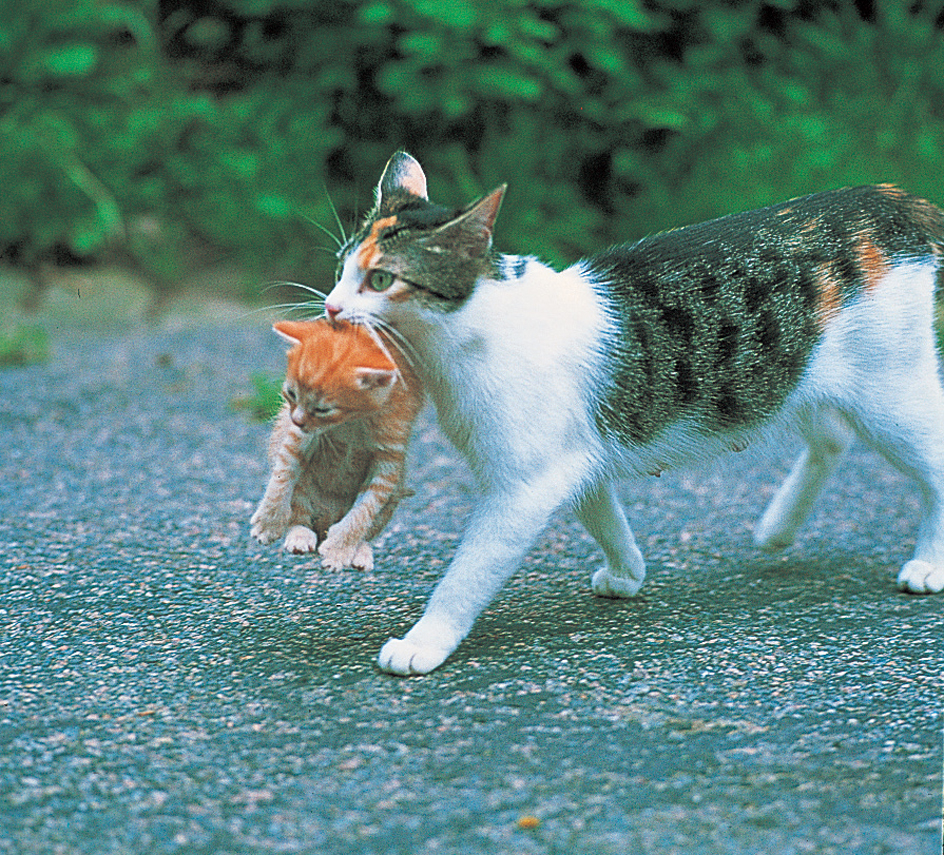
By about 5 weeks of age, kittens have most of their temporary teeth. They then begin to eat solid foods and to lap water. The mother usually begins to wean (stop nursing) them at about this age. The weaning process lasts several weeks.
When kittens are about 4 weeks old, owners should begin to handle them frequently and play with them gently. Kittens that receive such attention tend to become good pets. They learn faster and have fewer behavior problems than kittens that are ignored or overprotected. A kitten that has contact with a variety of people will be less fearful of strangers and new situations as an adult. Kittens can even learn not to fear dogs if they are allowed to play with a friendly dog.
By about 6 weeks of age, kittens have a fully developed brain and nervous system and can be safely separated from their mother. However, if possible, kittens should remain with their mother and their littermates until they are 9 or 10 weeks of age.
Kittens develop important physical skills by playing with one another. They also learn to get along with other cats in this way. In addition, kittens improve many instinctive skills, especially hunting skills, by watching and imitating their mother. The majority of cats reach their adult body size at about 1 year of age.
Cat playing
Communication.
Cats communicate with one another, with other animals, and with human beings in a variety of ways. Cats use sounds, body signals, and scents as means of communication.
Some experts estimate that a cat can make more than 60 different sounds, ranging from a soft purr to a loud wail, or caterwaul. These sounds originate in the larynx (voice box) in the throat. Cats can purr on both inspiration (breathing in) and expiration (breathing out). The sound is produced by air as it vibrates through the space in the larynx called the glottis.
The sounds a cat makes may have various meanings. For example, depending on the situation, a meow can be a friendly greeting, or it may express curiosity, hunger, or loneliness. Purring usually means contentment, but some cats also purr when they are sick. Hisses, growls, and screams indicate anger and fear.
Cat meow
Cats also communicate through various body and tail positions and facial expressions. A contented cat often lies on its chest with its eyes half closed. To invite play or petting, some cats roll over on one side and wave a paw in the air. However, a similar posture accompanied by extended claws, a direct stare, and ears folded back indicates a fearful cat ready to defend itself. A friendly cat may greet someone with its tail raised vertically. It may also bump its head against the person and lick an extended hand. An angry or frightened cat flicks its tail from side to side, arches its back, and puffs up its fur. A submissive cat crouches down, flattens its ears, and avoids direct eye contact.
Cats commonly communicate with one another by means of odors. Cats have scent glands on the forehead, around the mouth, and near the base of the tail. A cat rubs these glands against people and objects and so marks them with its scent. Only cats and a few other animals can smell these odors. A tom sprays urine on objects and so marks his mating territory.
Caring for a cat
Feeding.
Cats need a balanced diet. Such a diet supplies the proper amount of various nutrients, which provide energy and are essential for growth and replacement of body tissues. Cats require proteins, fats, vitamins, and minerals in their diet. The easiest way to meet a cat’s nutritional needs is to buy high-quality commercial cat food. The label should indicate that the food is “complete and balanced.” Cats should not be fed dog food because it does not meet their dietary requirements. A diet of mostly meat is unbalanced.
Cats are not naturally finicky eaters. But owners should give them a variety of commercial foods to prevent them from developing fussy appetites. Cats may occasionally be fed small amounts of such cooked foods as beef liver, eggs, fish, and vegetables. Many cats also enjoy milk, cheese, and other dairy products. However, such foods cause diarrhea in some cats. Owners should provide fresh drinking water at all times. Food and water bowls should be cleaned daily.
Kittens that have been weaned should be fed small amounts four times a day until they are 3 months old. They should eat three times daily until they are 6 months old, and then twice a day until they are full grown. Adult cats require only one meal a day, but many seem happier with two smaller meals. Food may be kept available at all times for a healthy cat that does not overeat. Sick cats, pregnant and nursing queens, and old cats often need special diets.
Grooming.
Cats instinctively clean themselves. They do so by licking their fur with their tongue. They also rub and scratch their fur with their paws. At least once a day, a cat licks a paw and washes its face and head with the wet paw. But not all cats groom themselves well.
Owners should brush or comb a cat’s fur daily to clean it and to remove loose hairs. In the case of long-haired cats, such care is essential to prevent the coat from tangling and matting. Daily brushing or combing also reduces the amount of loose hairs that cats swallow when they clean themselves. Swallowed hair may wad up and form a hairball in the cat’s stomach. Hairballs can cause gagging, vomiting, and loss of appetite. If a cat cannot spit up a hairball, surgery may be required to remove it. Owners may feed their cat a small amount of petroleum jelly or a commercial preparation once a week to prevent hairball formation. A veterinarian can suggest safe methods of administering such products. If necessary, owners may clean their cat’s ears with a soft cloth and brush their teeth with a cotton-tipped swab or a small toothbrush. Owners may also trim the tips of a cat’s claws.
Some cats—especially those allowed outdoors—become so soiled that they need a bath. Most cats dislike bathing. But if cats are bathed about once a month when they are kittens, they will become accustomed to water. Kittens also should be brushed or combed so that they will be easier to care for after they grow older.
Training
should begin when a kitten is about 8 weeks old. A cat can learn to respond to its name. Some cats can be trained to walk on a leash, or even to do such tricks as shaking hands and retrieving a ball. Training a cat can also be practical. For example, many people train their cats to calmly enter a carrier. This training reduces the stress of taking a cat to the veterinarian.
The most effective way to train a cat is with praise, petting, and food rewards for good behavior. Correct a cat immediately with a sharp “No” if it misbehaves. Always react to a particular action in the same manner so that the cat can learn what to expect. Owners should be patient with their pet and avoid using physical punishment. Some people spray cats with water after they misbehave. However, this punishment generally does not help cats learn to behave.
Cats should learn to use a litter box. Cats instinctively bury their body wastes, and so training them to use a litter box is easy. Kittens raised with a mother that uses a litter box will usually begin to use it themselves before they are 5 or 6 weeks old.
Any smooth-surfaced plastic or enamel pan can be used as a litter box. Put the pan in a quiet spot. Place a layer of commercial litter or sterilized sand or soil in the bottom. Sift the litter clean with a strainer each day. Clean the pan and change the litter whenever a third of the litter is damp or, at least, every fourth day. Most cats will not use a wet or dirty box.
Cats are most comfortable when multiple litter boxes are available. Some experts recommend having one more litter box than the number of cats in the house. For example, a household with two pet cats should have three litter boxes in different locations.
Dirty litter can spread disease. Cat owners, especially pregnant women, should take care not to directly touch the litter when cleaning the litter box.
Cats that have not learned to use a litter box at an early age must be trained. Place the cat in the box after it eats, when it wakes up, and after play. Praise the cat if it uses the box. The cat will soon learn to go to the box by itself.

Cats should also be trained to claw a scratching post instead of carpeting, draperies, and furniture. Cats naturally scratch at objects to pull off the worn outer layers of their claws and to mark their territory. A bark-covered log or a piece of wood covered with carpeting, cork, or fabric makes a good scratching post. Rub some catnip, a strongly scented herb that many cats love to sniff, into the post to attract the cat’s interest. Guide the cat’s front paws down the post. Whenever the cat begins to claw another object, correct the animal immediately and take it to the post.
Some owners take their pet to a veterinarian for declawing, which leaves the cat unable to scratch. Declawing is a surgical procedure in which the claws are removed from the paws. However, veterinarians recommend against this procedure. Scratching is a normal behavior for cats. When a cat cannot scratch, it is likely to develop behavior problems. For example, declawed cats often have difficulty using a litter box. Declawing is banned in many places.
Some cats enjoy chewing plants. But owners can train their cat to leave house plants alone, especially if they provide a pot of grass or oats for the pet.
Veterinary care.
Many veterinarians recommend keeping cats indoors, or only allowing them outside when on a leash. Cats can have all their needs met indoors, and generally will not become bored if they have enough space to climb and play. A cat that is kept indoors faces fewer health risks than an outdoor cat. Outdoor cats may be struck by automobiles, poisoned by pesticides, or attacked by sick or unfriendly animals. On average, indoor cats live longer than outdoor cats.
Inside the house, many cleaning products and certain houseplants are poisonous to cats. Such poisonous houseplants include ivy and philodendron. Owners should place poisonous items out of the reach of cats. Cats can also fall from open windows and unenclosed balconies.
Kittens should be taken to a veterinarian when they are about 8 to 10 weeks old for a physical examination. They should also receive vaccinations to protect them from common cat diseases. An adult cat should visit a veterinarian once a year for a checkup and additional shots. Veterinary care protects an owner’s health as well as a cat’s because some animal diseases can be transmitted to people. Such a disease is called a zoonosis.
Cat owners should learn to recognize signs of illness in their pet. A healthy cat has clean ears, clear eyes, a moist nose, pink tongue and gums, and a clean, glossy coat. Consult a veterinarian if a cat shows any change in appearance or behavior for more than 24 hours.
The most dangerous cat zoonosis, rabies, is an infection of the nervous system. Rabies is commonly transmitted by a bite from an infected animal. All cats, even those kept indoors, should receive periodic rabies vaccinations.
One of the most widespread cat diseases is panleukopenia, also called feline enteritis or cat distemper. This highly contagious infection is caused by a virus and is often fatal. Symptoms of panleukopenia include listlessness, loss of appetite, high fever, and severe vomiting and diarrhea. If a cat has several of these symptoms, call a veterinarian at once. All cats should be vaccinated against panleukopenia.
Two other serious diseases of cats are feline leukemia and the illness caused by the feline immunodeficiency virus (FIV). Feline leukemia is a form of cancer that affects the cat’s blood-forming organs and lymph tissues. This fatal disease is caused by a virus that also can cause other, nonfatal ailments in cats. FIV attacks the cat’s immune system and causes it to grow steadily weaker. Symptoms of the illness include infections, fevers, enlarged lymph nodes, and loss of appetite. FIV is spread by the bite of infected cats and can cause signs of illness many months or years after infection. Vaccinations exist for both feline leukemia and FIV.
Respiratory infections, ranging from mild colds to pneumonia, are common among cats. Signs of such infections include sneezing, a runny nose, watery eyes, and fever. A veterinarian can give vaccinations to prevent respiratory infections.
Many kinds of parasites may cause health problems in cats. Certain types of worms, including roundworms and tapeworms, can infect a cat’s intestines and other organs. Worms may cause listlessness, weight loss, vomiting, and diarrhea. Some other parasites may live on a cat’s skin and cause severe itching. Fleas and ear mites are the most common external parasites. Cats may also get ringworm, a skin disease caused by a fungus. Owners should remove parasites from cats to improve the pet’s health and to prevent the cat from transmitting diseases to people.
Birth control.
Each year, millions of unwanted cats are abandoned. Animal shelters must destroy many of these cats. Countless other strays die of starvation, injury, or disease. Because the problem of unwanted cats is so serious, owners should not allow their cats to mate unless a good home can be provided for the kittens.
Owners can try to prevent cats from mating by keeping them indoors. But this method of birth control is difficult. It also does not prevent such undesirable sex-related behavior as the spraying of urine by toms and the howling of queens during estrus.
A veterinarian can permanently prevent a cat from reproducing by neutering it—that is, by surgically removing some of the cat’s sex organs. Neutering also ends sex-related behavior. The operation is commonly called spaying when performed on a female cat, and castration when done on a male cat. In an effort to control cat overpopulation, many veterinarians now neuter cats any time after 6 weeks of age. Most cats, however, are neutered just before they reach sexual maturity, around 6 months of age in females and after 6 months in males.
Cat associations and shows
Cat lovers worldwide have formed many associations to promote interest in cats. The largest of these groups, the Cat Fanciers’ Association, Incorporated, has member clubs throughout the world. Cat associations register purebreds—that is, they record the ancestries of the animals—to ensure the preservation of the breeds. The associations also sponsor cat shows and establish standards for judging each breed. These standards cover such features as the shape of the body and the head, eye color, and coat type and color.
Breeders and pet owners display their finest cats at shows. Cats compete in groups based on such factors as age, sex, and breed. Show judges award points for healthiness, for temperament, and for how closely the animal meets breed standards. Cats that earn enough points may become champions or grand champions.
History
Scientists believe that members of the cat family gradually developed from a small weasellike animal called Miacis, which lived more than 50 million years ago. Miacis also was probably the ancestor of such mammals as bears, dogs, and raccoons. Members of the cat family first appeared about 40 million years ago.
No one knows exactly how cats were first tamed. But genetic studies reveal that the domestic cat is a direct descendant of an African wildcat that was first tamed—as early as 7000 B.C., by early farmers in the Near East. Domesticated wildcats killed mice, rats, and snakes and so prevented these pests from overrunning farms and grain storehouses. In ancient Egypt, the cats became pampered pets and were honored in paintings and sculptures.
By about 1500 B.C., the Egyptians had begun to consider cats sacred. They worshiped a goddess of love and fertility called Bastet, or Bast, who was represented as having the head of a cat and the body of a woman. If a person killed a cat, the punishment was usually death. When a pet cat died, the Egyptians shaved off their eyebrows as a sign of mourning. They made dead cats into mummies. Scientists have found an ancient cat cemetery in Egypt containing over 300,000 cat mummies.
Greek and Phoenician traders brought domestic cats to Europe about 1000 B.C. The ancient Greeks and Romans valued cats for their ability to control rodents. In Rome, the cat was a symbol of liberty and was regarded as the guardian spirit of a household.
Domestic cats spread from the Middle East throughout Asia. In the Far East, cats were used to keep rodents from destroying temple manuscripts and from attacking silkworm cocoons, from which silk is made. People of Asia admired the beauty and mystery of the cat. The animal became a favorite subject of artists and writers in China and Japan.
In Europe during the Middle Ages, the cat was considered a symbol of evil. Superstitious people associated the cat with witchcraft and the Devil. For this reason, people killed hundreds of thousands of cats.
Experts believe that the destruction of so many cats led to a huge increase in the rat population of Europe and contributed to the spread of the Black Death, an epidemic of plague. This disease is transmitted to people by rat fleas. In the 1300’s, it killed from one-fourth to one-half of the people who lived in Europe.
By the 1600’s, Europeans had begun to realize once again the importance of cats in controlling rodents. Cats gradually regained popularity. European explorers, colonists, and traders brought domestic cats to the New World during the 1600’s and 1700’s. Throughout the 1800’s, settlers took cats with them as they moved westward. Most cats in the United States and Canada today are descendants of these cats.
The first cat show was held in London in 1871. In 1887, the National Cat Club of Britain was formed. Interest in breeding and owning cats increased greatly. Today, the cat’s ever-growing popularity has produced a billion-dollar industry that provides services and products for cats and their owners.
Unfortunately, the popularity of pet cats has become a major problem for wildlife. Cats hunt whether or not they are hungry. Outdoor pet cats generally kill wild animals even if the cats are well cared for. In the United States, domestic cats kill billions of birds and billions of small mammals each year. In Australia, cats have hunted to extinction wild animals that were found nowhere else in the world. Researchers estimate that, on average, each outdoor pet cat in Australia kills nearly 200 animals each year. Scientists consider domestic cats to be one of the most harmful invasive species around the world. Cat owners can protect their cat’s health and their local ecosystem by keeping all cats inside.
